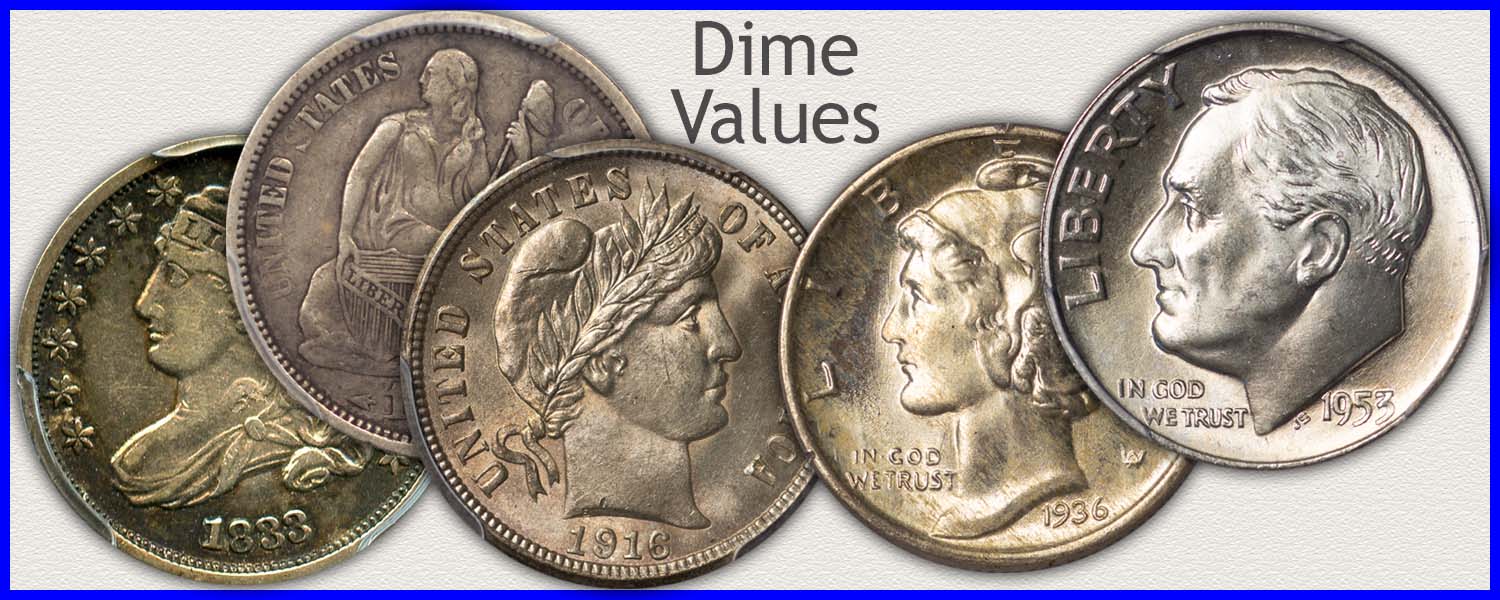Coin Values Moving with Precious Metals: Up-Dated 10/27/2025: Gold $4080 | Silver $48.30
Rising Bust Dime Value
Bust dime value reflects the historical importance of these old coins. A range of hundreds of dollars depending on date, variety, and condition is often found within the series. A step by step process accurately identifies distinct features of bust dimes.
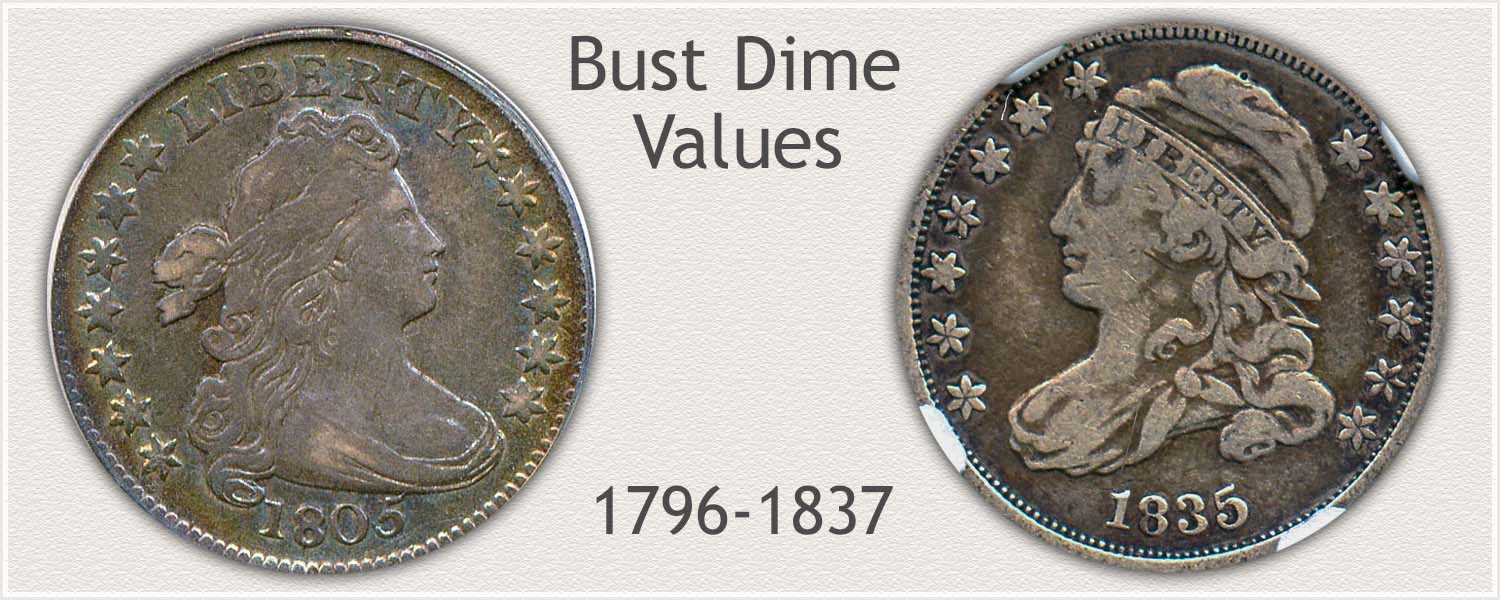
Steps Leading to Value:
- Step 1: Date and Variety - A large value difference in Early to Later varieties. An accurate identity of date is a must.
- Step 2: Grading Condition - Images and description help determine grade, important to value.
- Step 3: Special Qualities - Identifying originality of surfaces is a subtle insight into appeal and worth to collectors.
Review the chart and proceed through the steps below. Key elements to judge on your coin are imaged and described.
| Bust Dime Value 1796-1837 | ||||
|---|---|---|---|---|
| Condition of Coin | ||||
| Date | Good | Fine | Extremely Fine | Mint State |
| Bust Dime Value Updated | 2025 | |||
| Draped Bust Variety 1796-1797 | ||||
| $2,355 | $3,965 | $6,955 | $9,620 | |
| Draped Bust 1798-1807 | ||||
| $424 | $887 | $1,981 | $4,778 | |
| Capped Bust Type 1809-1828 | ||||
| $62 | $113 | $367 | $1,087 | |
| Capped Bust Small Type 1828-1837 | ||||
| $30 | $58 | $167 | $653 | |
| The Following are a Few Selected Dates | ||||
| 1796 | $2,355 | $3,965 | $6,955 | $9,620 |
| 1805 | $395 | $826 | $1,960 | $4,355 |
| 1807 | $454 | $949 | $2,002 | $5,200 |
| 1820 Lg. 0 | $68 | $111 | $295 | $1,275 |
| 1821 Lg. Date | $55 | $117 | $339 | $1,235 |
| 1825 | $65 | $110 | $340 | $1,077 |
| 1827 | $60 | $117 | $308 | $910 |
| 1828 | $78 | $178 | $466 | Rare |
| 1829 | $29 | $58 | $169 | $654 |
| 1830 | $32 | $57 | $137 | $529 |
| 1831 | $23 | $63 | $140 | $676 |
| 1832 | $30 | $54 | $143 | $696 |
| 1833 | $37 | $62 | $137 | $675 |
| 1834 | $27 | $59 | $175 | $655 |
| 1835 | $29 | $60 | $211 | $726 |
| 1836 | $32 | $54 | $216 | $592 |
| 1837 | $30 | $57 | $173 | $571 |
The above are wholesale values. Computed from dealer's price lists with various mark-up factors figured in. They reflect closely the value you would expect to receive when selling. Variations in value do occur subject to subtle grading points, collector demands and dealer needs.
For additional reference… CDN publishes a price guide, covering the retail Bust Dime Value in detail.
Step 1: | Date and Variety are Identified
Bust dimes are the first issues of the new US mint in Philadelphia. Draped bust design is notable for its scarce amount of surviving numbers.
Draped Bust Dime Variety 1796 to 1807
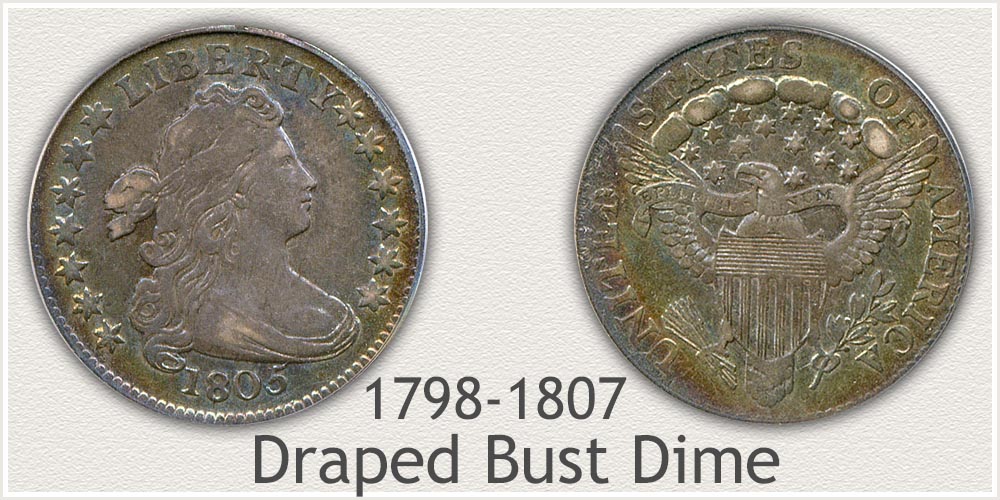
A bold portrait of Liberty is portrayed on the obverse. Loose hair flows across her forehead and down to cover her shoulder, tied in back with a ribbon. First reverse of 1796 to 1797 is an eagle standing on a rock grasping an olive wreath and palm branches. A redesign reverse introduced in 1798 is a heraldic eagle in reference to the Great Seal of the United States. An eagle with outstretched wings is holding arrows (war) in right claw and an olive branch (peace) in left.
Philadelphia mint was the only mint of the US at the time of these early dimes. Entire production amounted to just under 470,000 pieces over the 12-year period. A small amount of original mintage, advanced age, plus active use in commerce results in all are scarce today.
Capped Bust Dime Variety 1809 to 1837
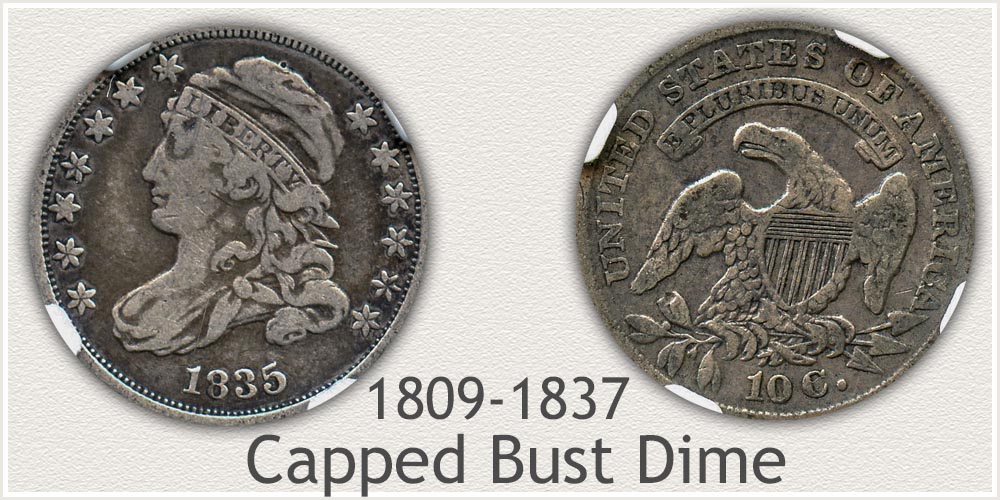
A new design to the dime in 1809 now portrays Liberty facing left wearing a "Liberty" cap. Her hair is held with a band above the forehead inscribed "Liberty". Long loose hair falls behind her neck to shoulder.
A completely new reverse is an eagle with the US shield and outstretched wings. Holding an olive branch in right claw and three arrows in left claw. "E Pluribus Unum" (the nations's motto - Out of many, one) is on a ribbon above.
Philadelphia continues as the only US mint striking all of the Capped Bust series of dimes. Production numbers of dimes increased as commerce grew along the eastern states and across to the west. A total just under 11 million pieces entered into circulation. Many continued in use for decades resulting the majority of survivors displaying heavy wear. Lightly circulated and finer examples are the exception.
Step 2: | Grading Condition: Identifying High Value Collector Grades
Grading condition of your coin now becomes key to finding an accurate value. With most of the Bust dimes today worn from circulation, identifying moderate to light wear narrows how much they are worth.
Grading Condition of Capped Bust Dime 1809 to 1837
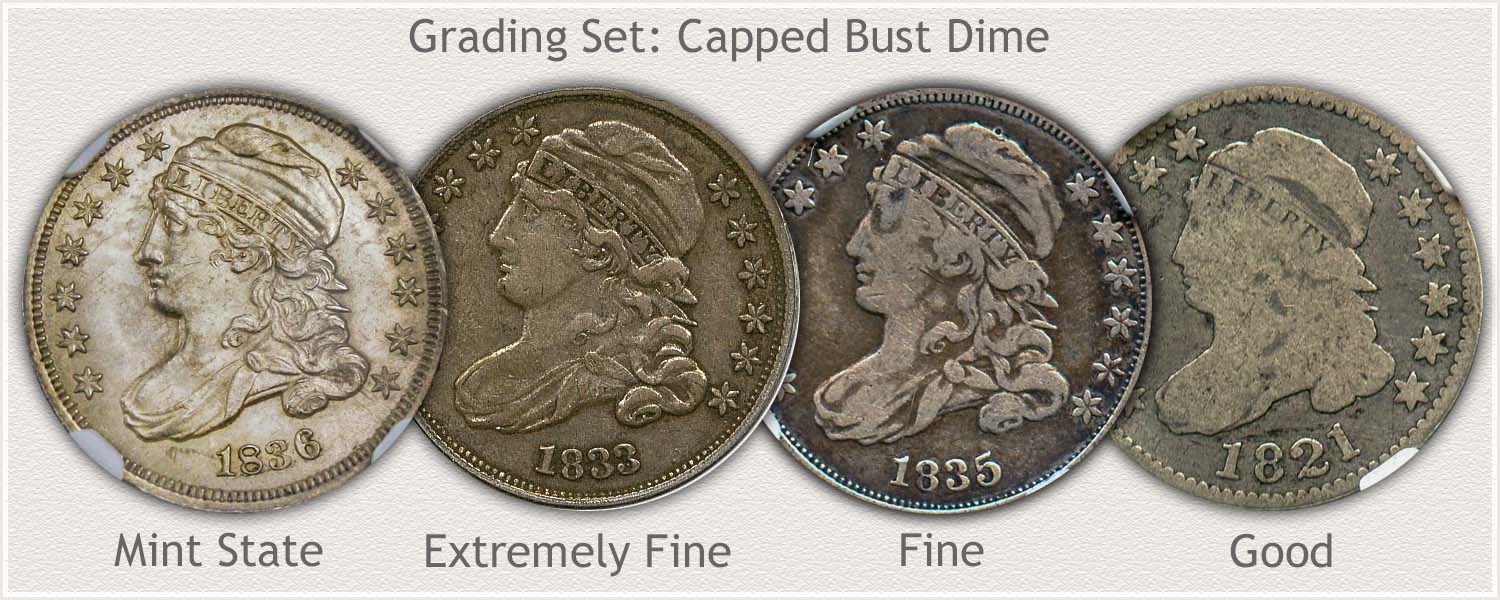
A close estimate of value is made when condition is judged and graded. Checking the value chart above shows an important value distinction between a Fine and Extremely Fine grade example.
Mint State Grade: Capped Bust Dime
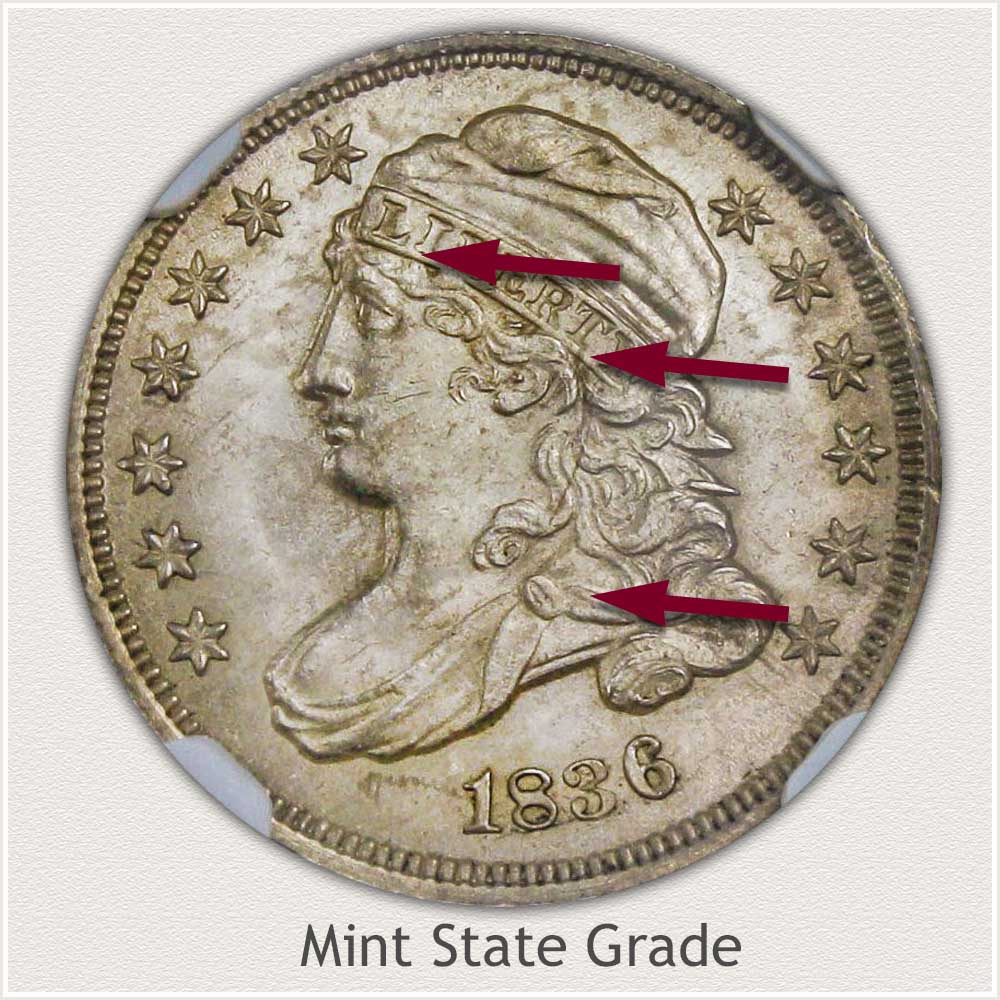
Obverse: Features Identifying Mint State Grade: Mint State dimes are without wear to the surface. No areas smoothed from wear defines the grade. Toning is often seen and somewhat diminishes the original bright luster but is not an indication of wear.
Inspect the small hair details just above Liberty's eye to judge no removal of metal is indicated. A complete profile to tops of curls in this area is needed to reach the grade.
Just above and behind her ear are waves of hair that remain with any smoothing or flattening.
The gown at the shoulder is held with a clasp. All high points are inspected for traces of wear. A flattened appearance to the ridges indicates wear.
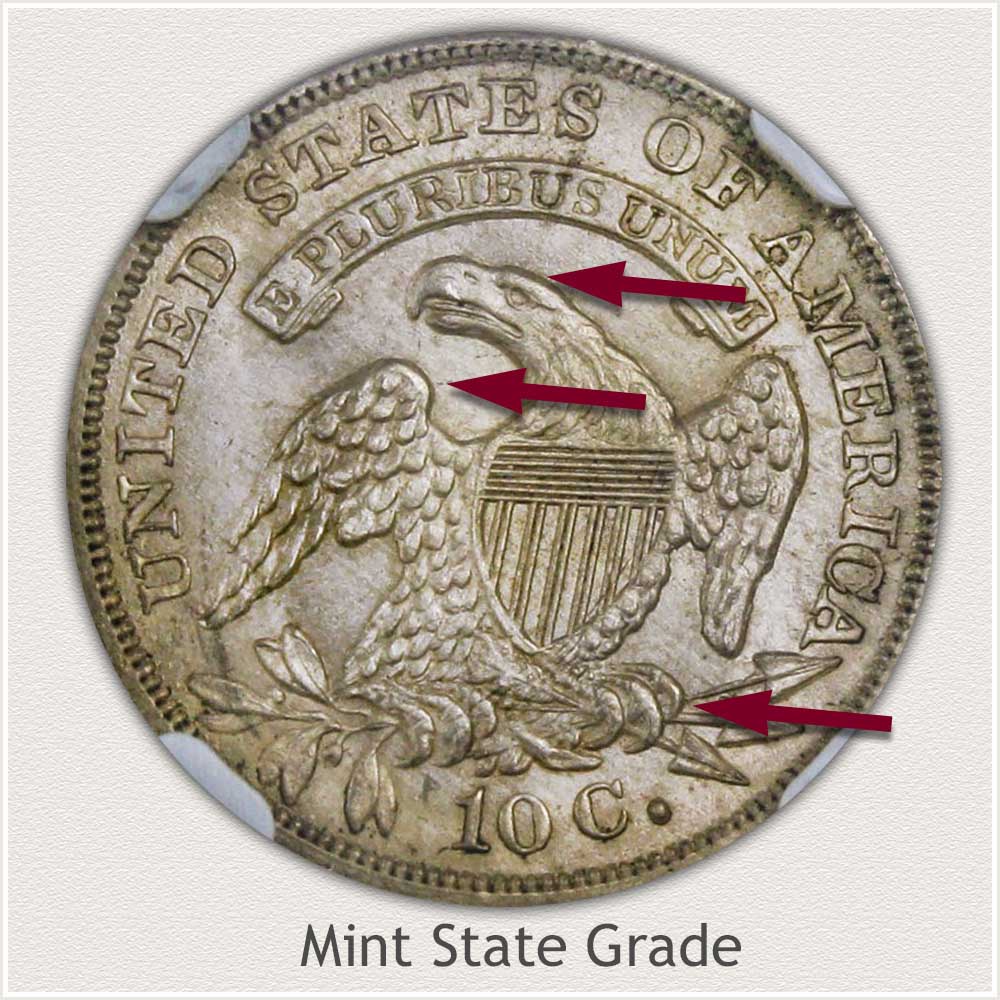
Reverse: Features Identifying Mint State Grade: Many high points present themselves to first contact on the reverse of a Capped Bust dime. Feather details, lettering, and a shield in the center. All are used to help define the mint state grade.
Along the upper and outer edges of the wing sit high on the coin. These remain rounded and high in profile without any flattening.
Above the eagle's eye undisturbed without traces of smoothing, along with the beak and neck feathers.
Look closely at the condition of the eagle's talons, any flat areas or dullness is indicating possible wear. If wear is present, a similar look of soothing and color to the metal is also found on the high points of feathers in the wings.
Extremely Fine Grade: Capped Bust Dime
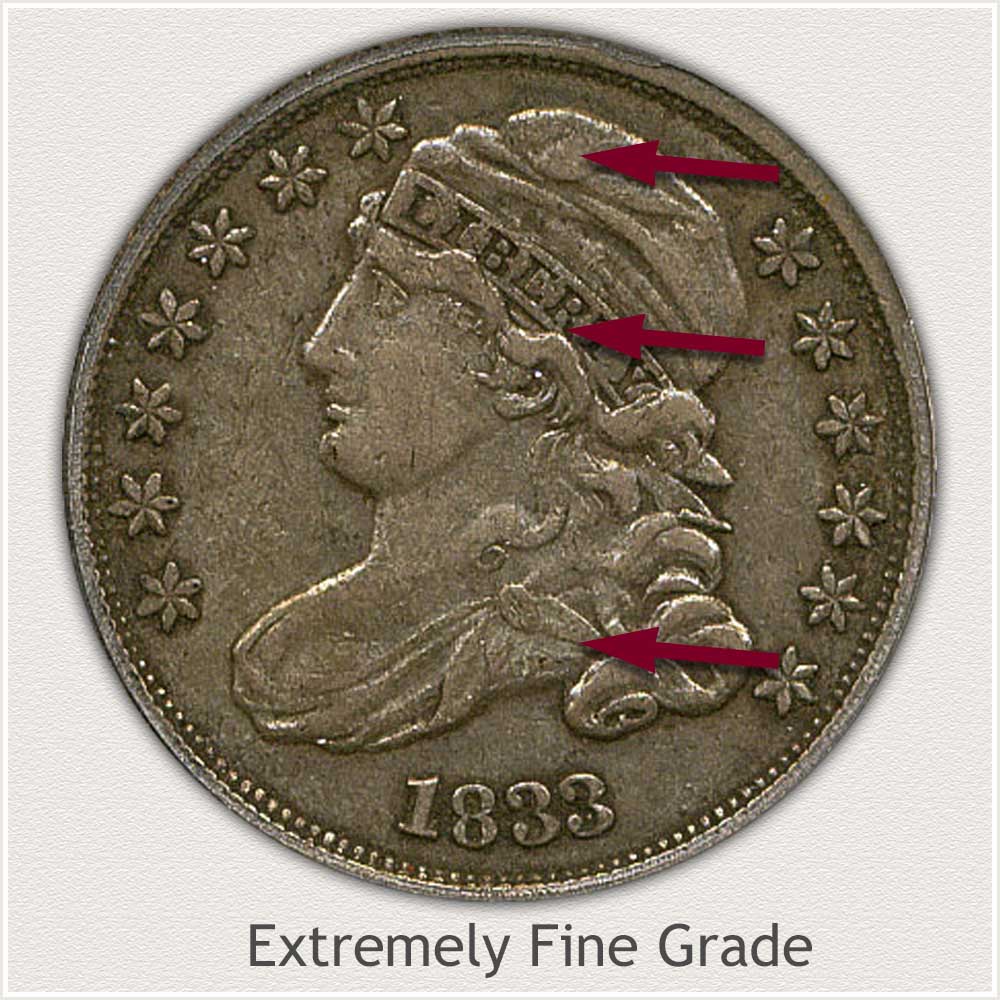
Obverse: Features Identifying Extremely Fine Grade: Small areas of flatness are visible across the surface, defining the Extremely Fine grade.
Hair details are first noticed as having areas of blending lines and small areas on top of curls have begun to flatten.
Above Liberty's eye and extending to above her ear are signs of wear. Areas of lost profile are evident; however, these flat spots remain disconnected.
Liberty's gown at the shoulder has lost detail. A clasp is fully visible and flatness on either side is limited to the edges of the material.
Folds in the cap are showing signs of wear, change in texture and flattening. Just above the "LI" is flattened slightly.
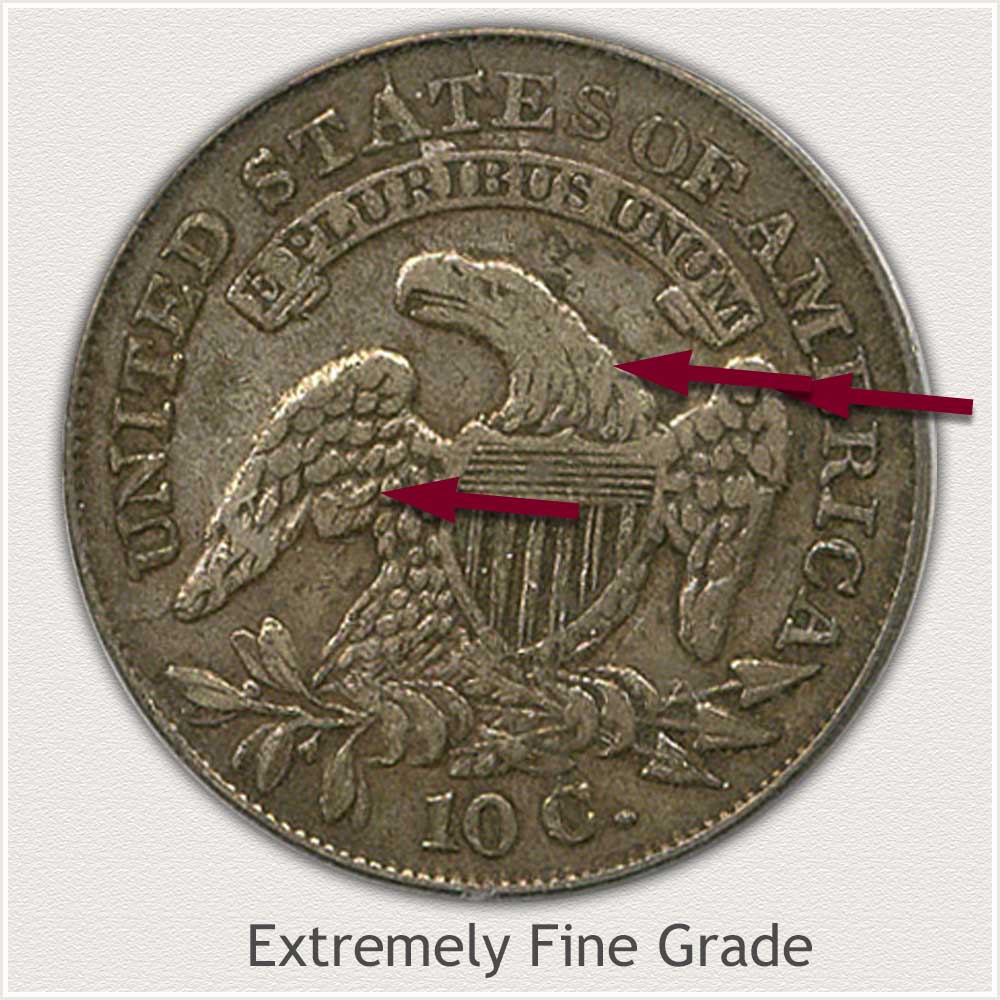
Reverse: Features Identifying Extremely Fine Grade: A majority of detail remains on the reverse of an Extremely Fine grade dime.
Wear is evident on just the tops of feather detail in the center of wings.
Along the edges of the wings, small disconnected flat areas are visible. These only remove small areas of metal.
Neck feathers remain bold, only high areas are worn. Contours remain between and defining the eagle's eye and beak.
Fine Grade: Capped Bust Dime
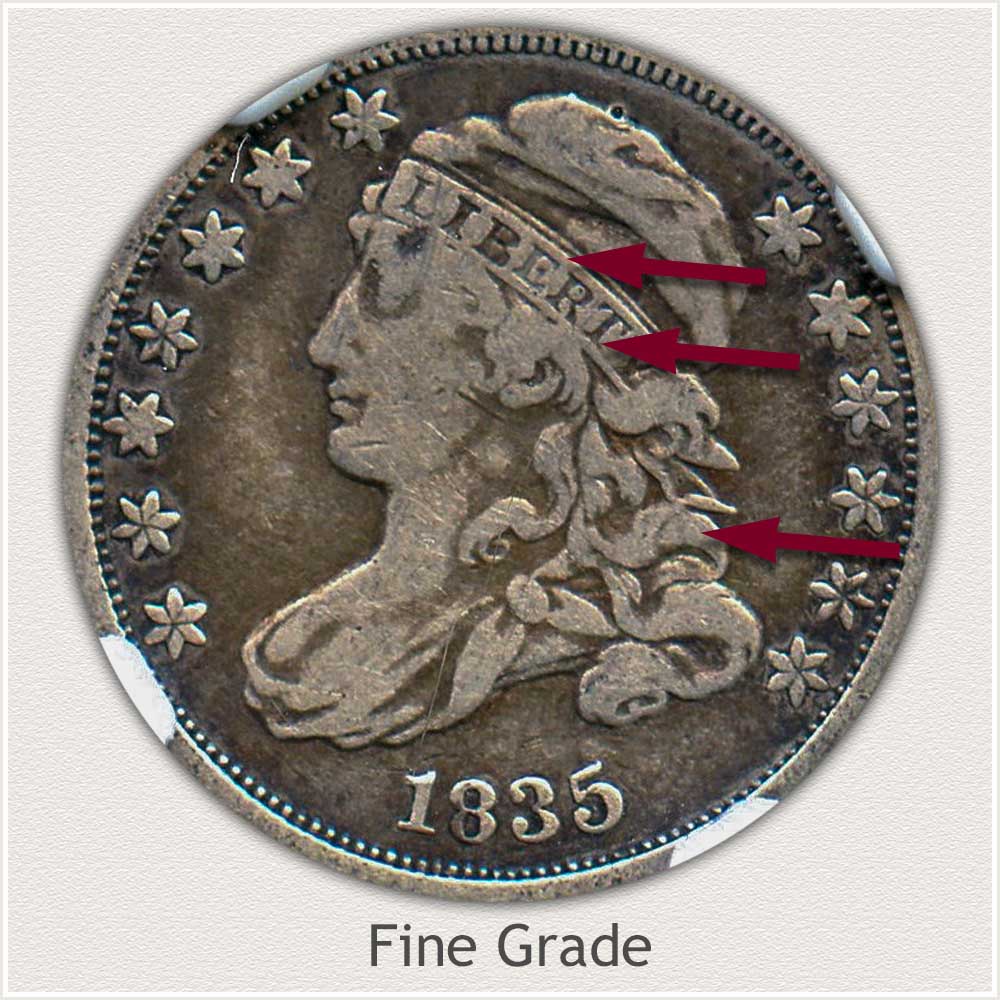
Obverse: Features Identifying the Fine Grade: Wear has now removed most fine details and leaving major details flattened.
Important to achieve the Fine grade is a full "Liberty" across the ribbon holding the cap.
Further inspection of the ribbon shows the lower edge is separate of the hair. Slight merging with the hair is just beginning to blend with the band in small spots; above the ear and a small area above the forehead. Majority of lower band line is fully defined.
Notice all major hair waves are flattened but no merging with each other. Along Liberty's neck a curl above her ear is visible, also a wave of hair just behind "Y" of Liberty.
Down Liberty's neck is evidence of major elements of hair; curls and waves are flattened but visible.
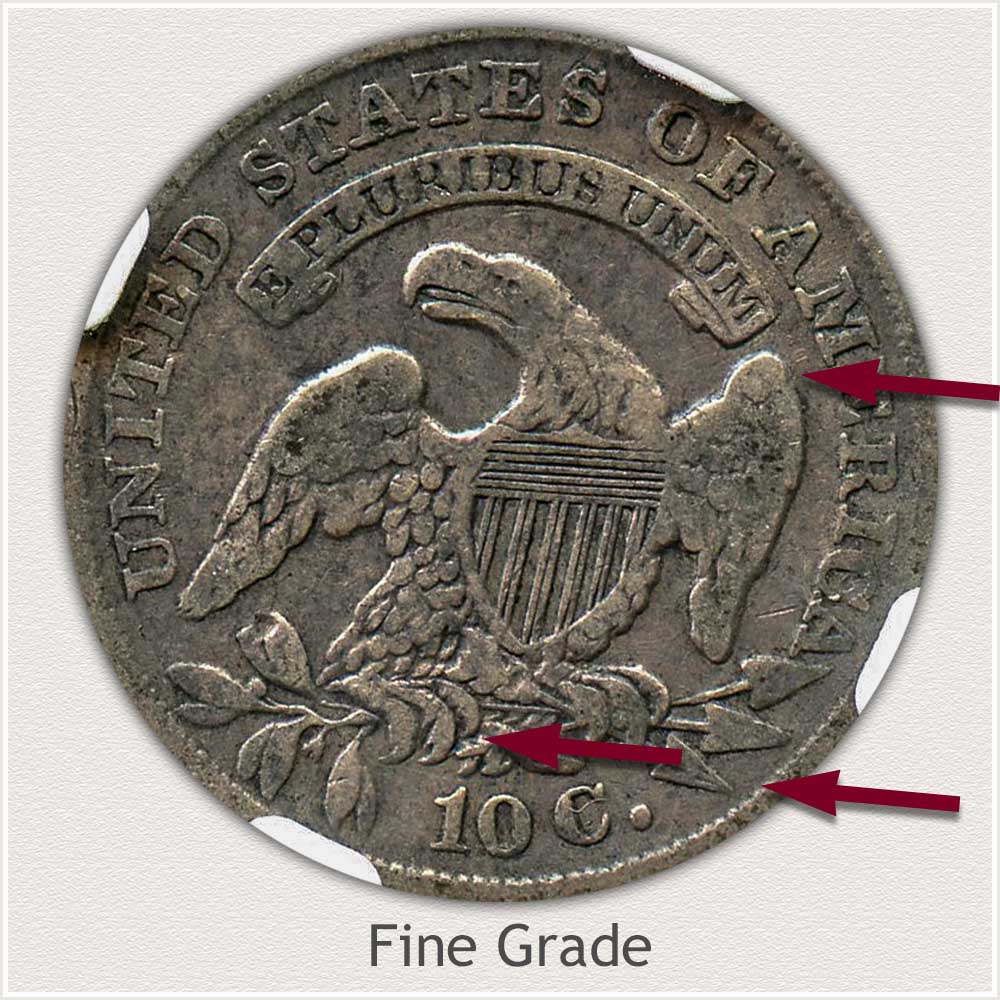
Reverse: Features Identifying the Fine Grade: A bold eagle remains in Fine grade.
Many outer feathers along the edge of the wings are smooth but leaving the majority of inner feathers defined. Clear feather detail remains close the edges of the shield.
Neck feathers are smooth and blending near the head with some detail of feathers showing just above the shield.
Arrow points are now flat from wear with no detail of a center ridge.
Talons are mostly distinct and separate although very flattened.
Good Grade: Capped Bust Dime
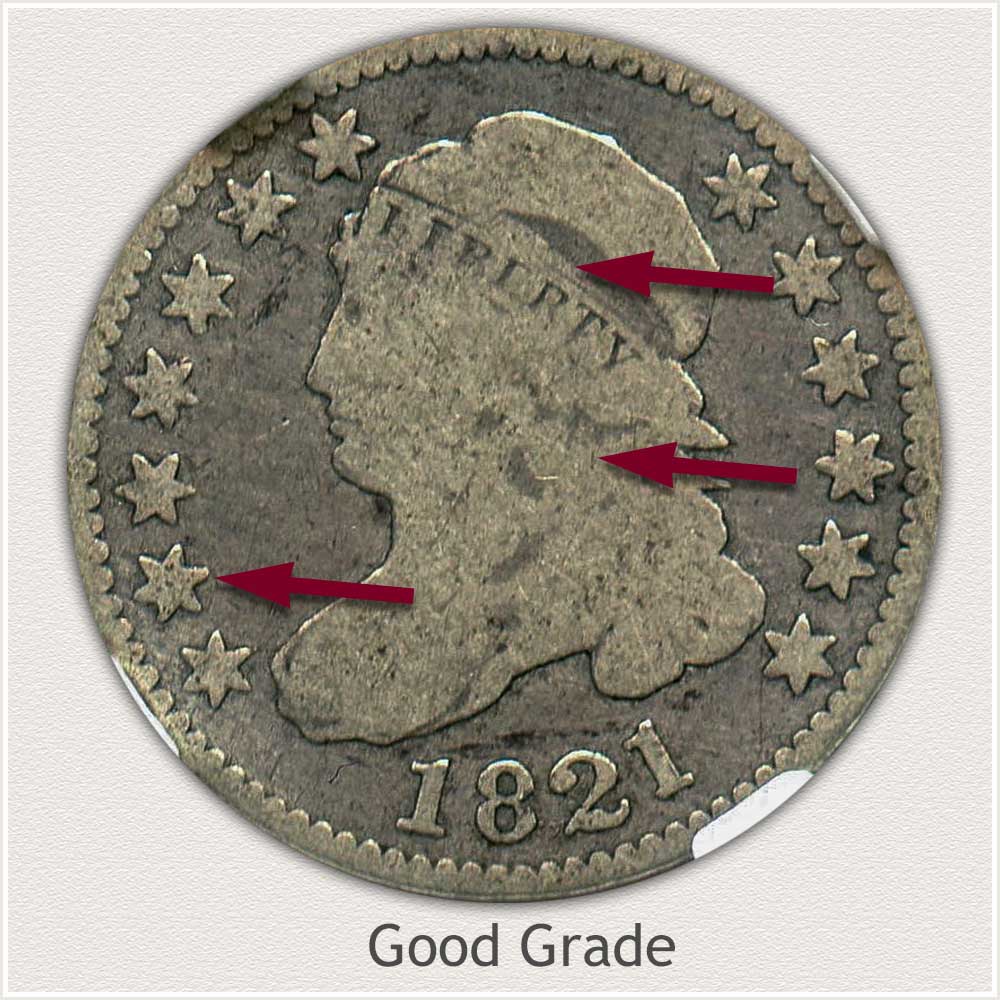
Obverse: Features Identifying the Good Grade: With the majority of design worn smooth a Bust dime is now in the Good grade range.
Liberty is well outlined and fully bold from the field. A few hair details often remain in the area under the ear.
Many letters of "Liberty" because of their depth are visible lending a distinction to the coin.
A separation of the upper band and cap is visible.
Stars are flattened and in areas sometimes touching the rim; majority of stars are clear.
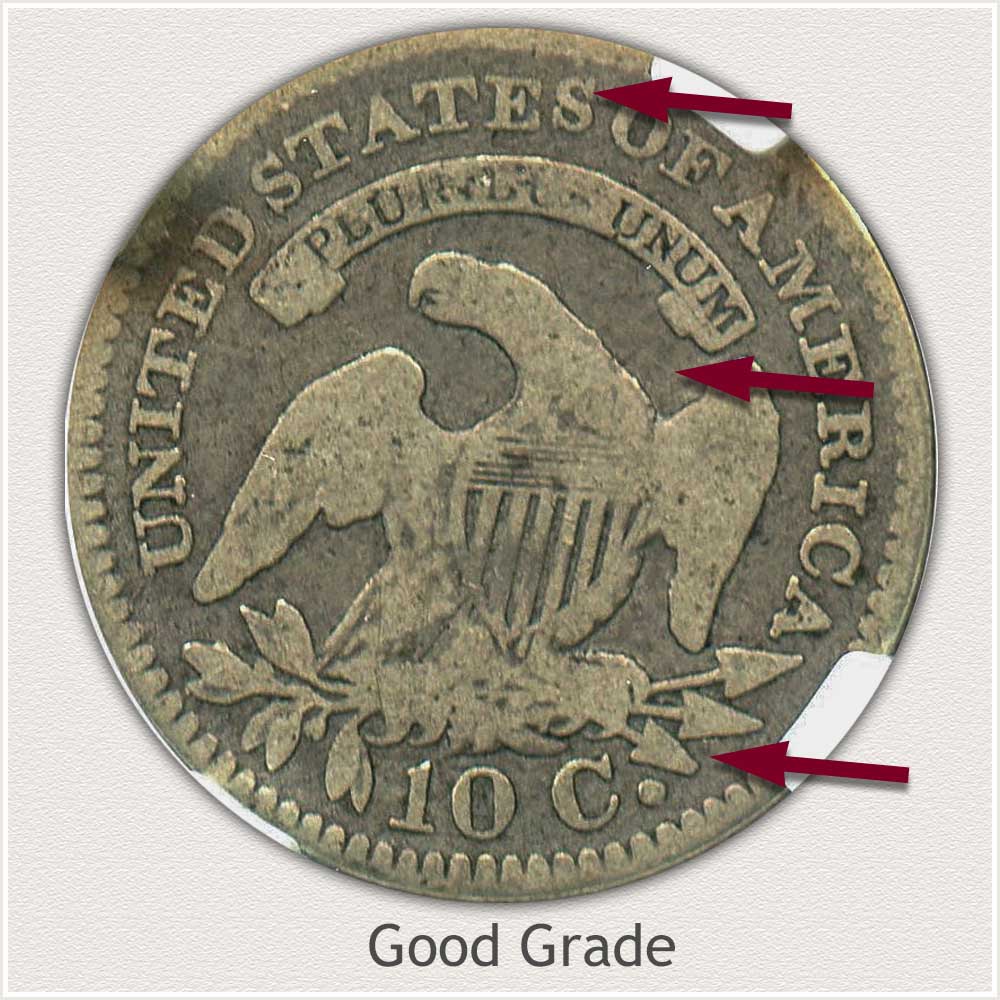
Reverse: Features Identifying the Good Grade: All major parts of the design are flat and heavily worn; defining the Good grade.
A complete outline of the eagle is well raised from the field. A few details in protected areas remain; notably, feathers near the shield and above the olive leaves.
Arrow points are distinct and free of merging with the rim.
Letters of the legend are well defined with weakness near the rim. Minor blending with the rim, if any, is limited to the tops of letters only.
Step 3: | Special Qualities Enhance Value to Collectors
Many collections of Bust dimes, by necessity, focus on circulated examples. Very few Mint State grade early dimes exist, and are highly valued. Harsh conditions of circulation destroy the pristine surfaces of a newly minted coin. Among the surviving circulated examples those with eye pleasing qualities are eagerly sought.
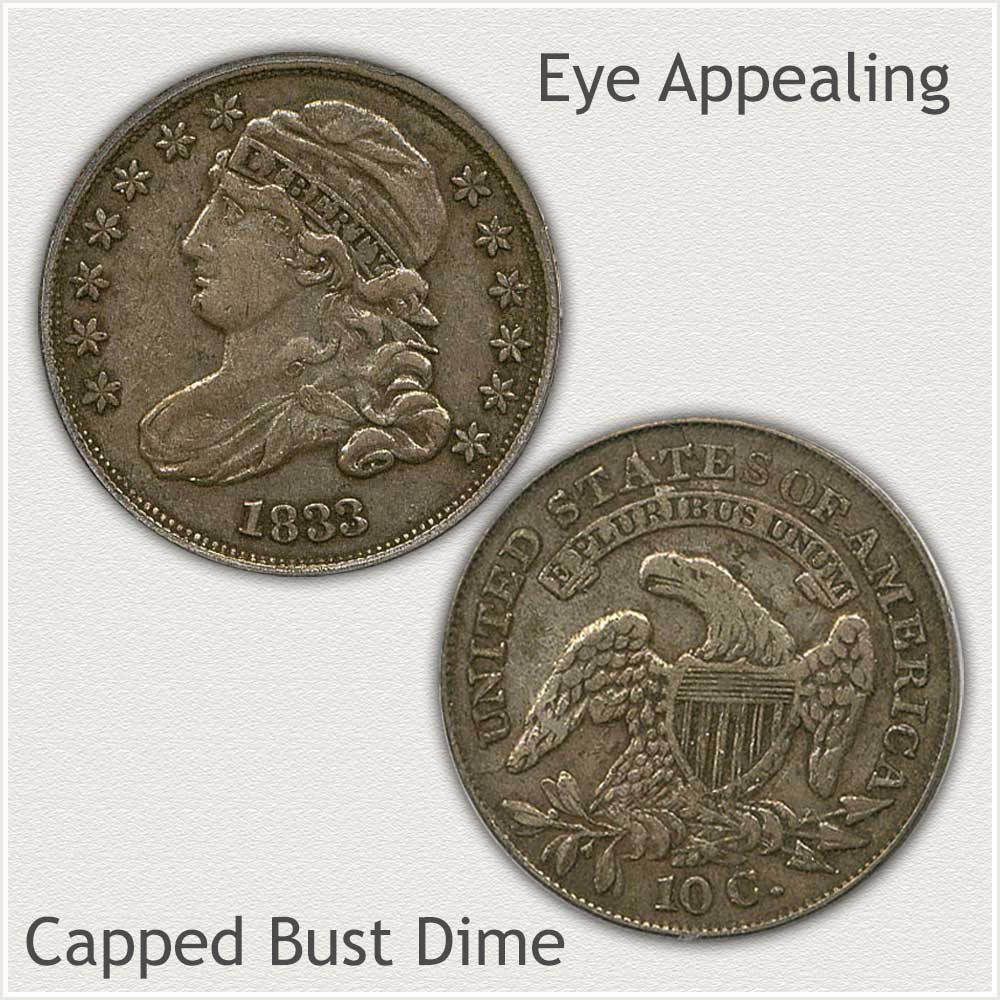
A pleasing example is the 1833 pictured. A soft tan-grey toning evenly covers lightly worn surfaces. Wear has not removed the aesthetics of the finer detail and the toning helps highlight remaining design. An interesting coin to view and study, notice the fine lines within all of the stars, indicating a well struck coin. Also, the toning matches obverse to reverse, a special find.
Silver, over time does darken and eventually become very deep grey to charcoal in color. Humid conditions deepen and accelerate the process and soon, toning "hides" many of the collectible qualities of even moderately worn examples. Storing your coin in a non humid area effectively ends the problem of overly dark coin surfaces. One point to follow is never - clean any of your coins. Removal or "improvement" of a coin's toning is the number one cause of lowering value. An "original" coin, no matter the appearance, is at the very least considered by collectors. A cleaned coin, any coin, is quickly passed by.
References
US Mint. Catalogue of Coins of the United States.
https://nnp.wustl.edu/library/book/554591
US Mint. 1948 US Mint Annual Report.
https://nnp.wustl.edu/library/book/339
Coin Values | CoinStudy Articles
Rare dates, rare condition, rare varieties, many factors contribute to bust dime value. Often growing slowly in value over the years, sometimes rapidly, seldom do they fall in value. Rise and hold, is the norm. Additionally; collectors are attracted to their historical importance. With their pursuit brings stable to growing demand.
Dime Values | Covering the Many Series of US Dimes
Discover how much your old dimes are worth. Bust, Seated Liberty, to Barber, Mercury, and the Roosevelt Dime series. Images identify the series and link to in-depth coverage of date, variety and judging condition. Accurately determine where on the value chart to value your dime.
Coin Value Guide | How to Value a Coin Collection
A step by step method combined with the coin value online guide identifies how to value a coin collection. Discover how much your box of old coins is worth.
★ Coin Values Discovery finds Bust Dime Value and...
All old US coin values. It is an excellent index with images and text links to all coin series, from Cents to Gold. Value charts, grading images and a step by step procedure uncovers how much your box of old coins is worth.
Selling Coins describes the different types of markets, and the type of coins to match each market. Extra effort for sure, but finding the best coin buyers yields the best results.
